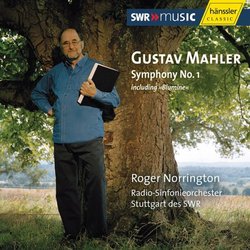| All Artists: Brahms, Gielen, Sinfonieorchester Baden-Baden Title: Symphony No 2 Members Wishing: 1 Total Copies: 0 Label: Hanssler Classics Original Release Date: 1/1/2006 Re-Release Date: 2/14/2006 Album Type: Import Genre: Classical Style: Symphonies Number of Discs: 1 SwapaCD Credits: 1 |
Search - Brahms, Gielen, Sinfonieorchester Baden-Baden :: Symphony No 2
 | Brahms, Gielen, Sinfonieorchester Baden-Baden Symphony No 2 Genre: Classical
|
Larger Image |
CD Details |
CD ReviewsA special recording but not for everyone Larry VanDeSande | Mason, Michigan United States | 02/14/2006 (4 out of 5 stars) "Roger Norrington isn't a name most associate with the symphonies of Gustav Mahler. The period perforance specialist has made a name for himself over two decades as keeper of the way things used to be in classical music. He has alienated a lot of conservatives with his tendencies including heightened speeds, clipped phrases, lack of string vibrato and portamento.
Indeed, this concert recording of Mahler's Symphony No. 1 is played vibratoless and without slides by the Stuttgart Radio Symphony. Norrington explains in the notes to this issue that this is the first recording of the symphony the way Mahler would have heard it. He suggests the practice of routine vibrato was popularized by Fritz Kreisler after Mahler's death. True? Maybe. Does it matter? I don't think so. Like Norrington's other recordings, his approach here is a bit on the fast side without vibrato or portamento. He is aided by good horn playing, exquisite woodwind playing and a truthful recording that may be a tad light on bass. You can easily make up for this by adjusting the controls on your equipment to give this recording the dimension you wish. This perforamance includes the "Blumine" movement. Norrington's notes say this was included in Mahler's first few performances and was meant to be a "love interlude" as a fifth of his intended action-reflection-action-reflection-action & reflection symphony. Norrington leads the movement as if it were a love interlude making it romantic and somewhat repetitive. His harp is very lean. The third movement is good but metronomic in the initial subject and emphasizes the lean bass in the recording. Norrington and forces relax more in the second subject. The fourth movement begins without any hint of mystery with bare timpani, cello and bassoon. The wedding music is more humanistic and what follows has much greater elasticity in phrasis and tempo than the earlier work. The 19-plus minute finale begins with an onslaught of great urgency that signals this will be the most important section of the symphony. Norrington is most relaxed and almost kindly in his approach to the romantic second subject before the blazing chorale signals the end in near. That ending recaps the symphony in a triumphal blaze of sound. The audience waits a second or two before rewarding the troops with egregious bravos and applause. My benchmark performance of this symphony has always been Bruno Walter's final statement issued by CBS (Columbia, now Sony) in 1961 with the so-called Columbia Symphony Orchestra. Being Mahler's protege and top student, I've always assumed Walter has the greatest insights into the symphony of stereo era conductors. I found it most interesting that Norrington overall timing in the traditional four movements -- while quite different movement by movement -- is not that far off from Walter's in total. Here is the comparison: Norrington 1: 15:04; 2: 7:36; 3: 9:39; 4: 19:30. Walter 1: 13:21; 2: 6:50; 3: 11:23; 4: 20:22. I can't say Norrington's new CD displaces Walter's as my favorite but it provides an interesting alternative with the Blumine movement. I wasn't too thrilled with the newcomer through the first four movements until I heard that finale, where Norrington bursts forth with much passion and commmitment. It changed my mind about the entire performance and caused me to grade this issue upward an entire star. How you respond to this will depend, in part, on your opinion of informed historical practice and your preference on the sound of massed strings. If you like luscious string sections, vibrato or slide, you're not going to be very happy with this recording. If you are a period performance entusiast, you are going to experience something new and different here you may never have heard before. In you are in the middle of those extremes -- like me -- you may have a favorable reaction to this. I expect this CD to show up both on some critics "Best of 2006" lists and for it to show up on some critics "Worst of 2006" lists. Like much from this source, opinions will be sharply divided and polarized. I'm going to continue playing this and see if it grows on me. I was very surprised at the way I turned my opinion around in the final movement. That has always been the portion of this symphony I most liked so perhaps it is the music, and not the interpretation, speaking to me. But I also generally enjoy Norrington so I'm willing to hang on longer and see what happens. I think, based on what I've said here, you should have a pretty good idea whether or not you'd like this performance." |

 Track Listings (5) - Disc #1
Track Listings (5) - Disc #1